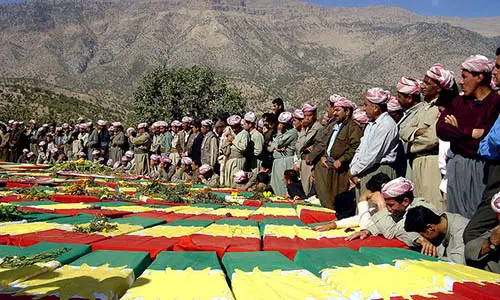The Kurdish Genocide was an act of extreme brutality conducted mainly under the regime of the then President of Iraq, Saddam Hussein. Also known by the largest campaign undertaken within the genocide- the ‘Anfal’ campaign, it took place with the intention of exterminating the Kurdish population of Northern Iraq, mainly between February and September 1988. This act was at the height of the war between Iran and Iraq, and was conducted in retaliation to Kurdish support to Iran. Here are some heart-chilling facts about this pogrom-
1. Deaths
About 182,000 Kurds ‘disappeared’ or were killed in the mass execution, and 90 per cent of the villages attacked. Young and healthy men were the main targets of the campaign, and about 70 per cent of the killed were men in the age group of 15-50 years. Executions would usually take place ruthlessly, with mass graves and blindfolds robbing the victims’ dignity.
2. Destruction of villages
Over 4,500 villages were razed between 1976 and 1988, leading to loss of agricultural resources and Kurdish cultural heritages. The razing of 1,200 villages during the Anfal campaign alone, plus the violence, led to over 100,000 Kurds fleeing to Iran; and about 27,000 to Turkey.
3. Collective towns
Collective towns were reservation-like refugee areas where the remaining Kurd population was shifted forcibly. These towns mainly comprised women, children, and men above the age of 70; since others were killed by the Iraqi army. Those who refused to shift were shot dead.
4. Timeline
The genocide was preceded by a multitude of anti-Kurd activities by the Iraqi government as a part of its Arabisation policy. In an attempt to employ poor Arab men in the oil-rich areas of Northern-Iraq, the Hussein regime started to slowly displace the Kurds living in the region, either by appropriating their property or through killing. This happened through 1960s in Kirkuk, a region where about 780 villages were affected. This happened in 1969 with the Dakan village burning of 69 women and children hiding in a cave, all of whom were burnt alive. This happened with the deportation of the Faylee Kurds through 1980s, and with the disappearance of 8,000 men and boys of the Barzani tribe of Kurds in July-August 1983. These incidents show the systematic efforts to exterminate the entire Kurd population.
5. Chemical weapons
The largest chemical attack ever after World War I took place in the Kurdish town of Halabja on March 16, 1988. Gases- like Sarin, mustard gas and Tabun- killed 5,000 people and injured 7,000, making it the largest chemical attack on a civilian population in history. This is how the Hussein’s brothers, Ali Hassan al-Majid, who was in-charge of these operations, acquired the infamous moniker of Chemical Ali.
6. International response
For all the inhuman and brutal activities perpetrated during it, the Kurdish genocide received little international attention despite sustained media coverage. The Halabja episode, for example, was revealed to the West within days due to the Irani government’s efforts of air-dropping journalists into the town. Iraq was being supported by the Reagan administration against Iran during the war, and any international pressure on the issue began only after the Iran-Iraq ceasefire was signed in the August of 1988.
7. Documentary evidence
The Kurds revolted against these atrocities by the Iraqi regime in 1991. This uprising led the Kurdish rebels to seize about four million secret documents- about 18 metric tonnes- of the Iraqi Army in the region. These documents- comprising eyewitness accounts, forensic details and more- helped in the reconstruction of the entire Anfal campaign. This also led to the plea to establish a war-crimes tribunal, which led to trials of the accused starting 2004.
8. Al Anfal
Al Anfal literally means the Spoils of War. It is also the title of the eighth chapter of the Koran which records the first victory of Mohammad over non-believers. This characterisation of Kurds as blasphemous people was to rouse support for their genocidal campaign, though nowhere in the Koran is there a mention of mass killings of hapless innocents.
9. Formal recognition of genocide
No government, except the Iraqi government itself in 2011, has formally recognised the campaign as genocide. Although several parliaments like that of the U.K., Norway and Sweden have accepted it; formal recognition on behalf of the governments is still lacking. In fact, even the United Nations has not raised a resolution for vote regarding this. This international complicity is to avoid the compensation these countries might be liable to provide for their support to the Hussein regime.
10. Survivor’s tale
Tamyour Ahmad was 12 when he witnessed a host of human rights’ violations at the Popular Army camp in Topzawa near Kirkuk. He was then taken to a near the Saudi Arabian border and shot twice after which he played dead to escape further bullets. Once the soldiers left, he escaped and reached a Bedouin camp several hours away. In 1992, he narrated his story to Human Rights Watch, and became one of the very few survivors of the genocide.











Leave a Reply